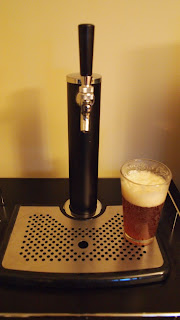This beer will be traditionally served with sparklers or tiki torches sticking into the beer glass.
Just kidding. I had leftover hops and crystal malt and I wanted to make a "lighter" beer for our house guests that are coming over on the 21st of this month. I named it after my little sister who is gaining a year on the 19th.
Here is my recipe:
1/2 lb crystal malt 40 L - preboil
6 lbs Breiss' Rye malt extract - 60 minutes
1 oz Centennial pellets - 50 minutes
1/2 oz Cluster pellets - 30 minutes
1 tsp Irish Moss - 15 minutes
1 oz Willamette leafs - 10 minutes
My brewkit came with a bottling vessel and so I used it as a fermenter for this ale.
I liked Breiss' extract way better. The label was easy to remove and the extract was also much cheaper than the "Cooper" that I used for Little Bear's Brown Ale.
The wort for this beer tasted really hoppy and I only got a starting gravity reading of 1.0048. I'm a little nervous that the beer will be too light - but hopefully those yeasts will do their thing.
My trusty assistant must love the smell of hops:
Day 6 update:
The airlock wasn't producing a lot of activity so I took the opportunity to dry hop the brew with an ounce of Cascade hops.
Sure enough - when I opened up the lid - there was almost no activity. The krausen was pretty much gone at this point. Must have been some good yeasts. My original gravity reading was 1.048 and at this point my reading was at 1.013. Not too shabby. That would put the ABV at around 4.6%. I guess we will call it a session beer.
I put the whole leaf cascade hops into a muslin bag and weighed it down with a solid shot glass (it had a heavy bottom to it - hopefully it did the trick). Of course I boiled the bag and glass prior to putting it in my beer.
I tasted my sample of course. It was bitter without much aroma (hopefully the dry hop will help that) and a slightly dark color. I have renamed the beer "Shea's Fire Red Ale" to compensate for the color changes.
I also took the time to get my corny keg ready. I plan on putting it into the keg in a week or so.
Day 9 update:
Well the gravity reading this morning was still 1.013 so I decided to keg the beer so that it would have time to slowly carbonate and settle down.
First I cleaned the corny keg out and replaced all of the gaskets. The inside of the keg was clean but the gaskets were gummy and sticky - so I'm glad that I did this.
Second I went to Irish Welding Supply in South Buffalo to fill up my CO2 tank and I also stopped at the kegworks for some new gas line.
After filling the empty keg with CO2 I siphoned the beer into the keg and sealed it off. I bubbled some CO2 into the keg through the beverage end and "burped" it from the gas side to get all of the oxygen out of the keg. I then thought it would be a good idea to put the beverage tap on - even though the beverage line was not hooked up. This of course caused beer to be shot out of the keg and across my kitchen. I do not recommend that anyone do this.
So after cleaning up beer I put the keg in the kegorator and hooked up the CO2 so that it can slowly carbonate. I'm going to try and pour a beer Sunday and then maybe on Tuesday as well (for band practice).
Day 10 update:
Ok, well it is done. My first finished batch of beer. I wanted to test the carbonation levels everyday so I poured my first beer. It isn't bad - probably will be better after a week of aging or so - but it's completely drinkable. Not a ton of carbonation - but it pours with a nice head and it's not too bitter. Probably could have used some more time with the dry hops - but it does have a floral aroma. The color is a bit foggy so hopefully a few days and it will settle down.
So there it is in the keg and ready for some drinking!
And that concludes this blog entry. My next update should be that my brown ale has finally stopped fermenting - although this might never happen at this rate.




Yeah brewskies! You gotta post an update about how awesome the final product was.
ReplyDeleteThe beer was awesome.
Delete